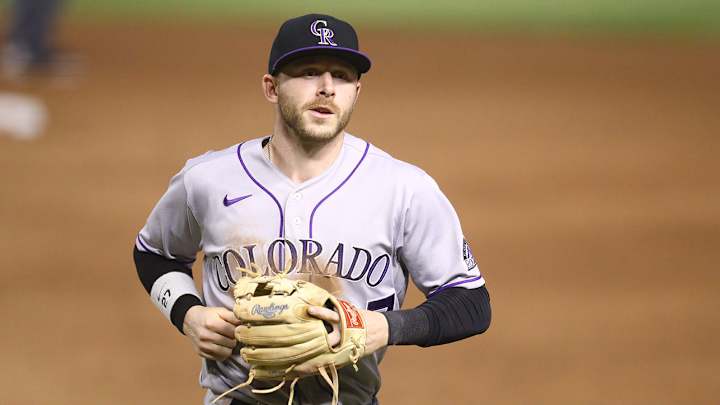Need a Shortstop? Now Is the Time to Get One

Not much has changed in the week since the Mets traded for Francisco Lindor and Carlos Carrasco. The deal between the Big Money Mets and this offseason’s best trade candidate did not exactly jolt the market. Top free agents Trevor Bauer, J.T. Realmuto and George Springer remain unsigned.
With few exceptions, the powers that be in the hedge fund-ified front offices seemingly are more interested in cost efficiency now than ever before. (As evidenced by DJ LeMahieu's reported $90 million deal with the Yankees, in which New York gave the 32-year-old a six-year deal to deflate the contract's average annual value.) The pandemic plummeted team revenues in 2020, and despite word from commissioner Rob Manfred suggesting a 162-game schedule will be played this year, that’s yet to be decided. On top of that, the collective bargaining agreement expires Dec. 1, with bitter negotiations between the owners and players association expected to follow. And then comes next offseason’s superstar free-agent class.
All of these factors contribute to the uncertainty that remains this offseason, even with pitchers and catchers (supposedly) just weeks away from reporting to spring training. Yet, in the aftermath of the Lindor trade, there are plenty of reasons why this is precisely the right time for teams that need a shortstop to get one.
As it stands, five of the best shortstops in baseball—Lindor, Corey Seager, Trevor Story, Javier Báez and Carlos Correa—are all set to hit free agency after this season. The assumption is that teams in need of a shortstop would rather wait to splurge on one of them than open their checkbooks now. For some clubs, especially the big-market ones, that’s a logical choice. None of these shortstops will come cheap. Boston’s Xander Bogaerts, who signed a six-year, $120 million extension, is the highest-paid shortstop in terms of average annual value ($20 million). Lindor, Seager and Story should get at least that much—probably more—on the open market with Báez and Correa not far behind.
Given Steve Cohen’s financial resources and the group of players New York sent to Cleveland—including their two MLB-ready shortstops, Amed Rosario and Andrés Giménez—the Mets are the favorite to sign Lindor beyond this season, presumably via an extension. That would leave four shortstops in the superclass to court.
With or without Lindor, an alternative approach for teams would be to upgrade at shortstop now. The three best free-agent options are Didi Gregorius, Marcus Semien and Andrelton Simmons. In this pandemic-diminished market, it could be more prudent to sign one of these good-not-great shortstops to, say, a two-year deal. That way they are free to pursue some of next winter’s other top-tier free agents (among them: four Cy Young winners, five MVPs), while other teams are bidding against one another for the elite shortstops.
Gregorius, who turns 31 next month, returned to form last season in Philadelphia. He played all 60 games and hit .284 with 10 homers and an .827 OPS. He’s a good defender with a strong arm and a great clubhouse guy. His projected market value is $10.3 million per year over two years, according to Spotrac.
Semien, 30, finished third in the AL MVP race in 2019—he had 8.9 bWAR, hit .285 with 33 home runs and played in every game—but regressed last season. His .679 OPS was his lowest since 2014, when he was still a utility man with the White Sox. Spotrac projects his value to be worth $19 million annually over three years, though I’m skeptical any team would give him such a deal after his down 2020 season.
Simmons, 31, is one of the best defensive shortstops ever, and not long ago he was a productive offensive player. However, after two injury-filled seasons, it’s unclear how much he has left. A one-year prove-it deal makes a lot of sense, with Spotrac projecting his value at $7.5 million.
Each shortstop brings something different. Gregorius is the most consistent of the trio, excluding his 2019 season, when he rushed back from Tommy John surgery. Semien has the most upside; just look at what he did in 2019. Simmons should be the most affordable, and he has the best glove.
Another strategy could be trading for Story. The Rockies won't contend in 2021, and they could lose their two best players at season’s end. (In addition to Story, Nolan Arenado can opt out of his eight-year, $260 million deal.) Colorado risks both players leaving and getting nothing in return if it doesn’t trade one or both of them. Arenado could be more difficult for the Rockies to trade. He has a full no-trade clause and is owed more than $150 million if he doesn’t opt out. Meanwhile, Story’s salary for 2021 is $18.5 million.
Similar to what the Dodgers did last year with Mookie Betts and what the Mets will try to do with Lindor, a team that trades for Story could also work to extend his contract before he becomes a free agent. If that happens, along with a Lindor-Mets extension, the great class of free-agent shortstops next winter has just three members.
Of course, the Mets' acquiring Lindor doesn’t mean Story will get traded or teams will decide that now is the time to sign Gregorius, Semien or Simmons. Instead, it’s better to look at the Lindor trade not as the first domino to fall but as the board on which all the pieces are set. It may not be the force that kicks the series of events in motion, but none of what comes next could happen without it.
